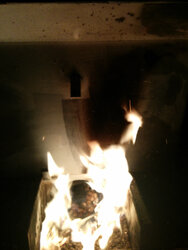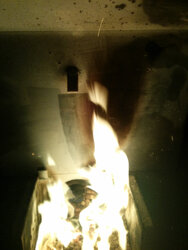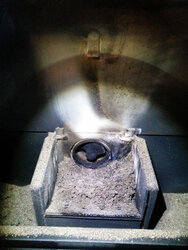Hi all. I've been reading through these forums for over a year now (back when I was first considering purchasing a pellet stove for this winter.) I finally purchased one a month or so ago and finished setting it up 10 days ago. The install took me a while because, as with most home improvement projects, one thing lead to another and my wife had asked me to tile from our front door to where I was setting up a hearth area. Originally, I was just going to build a simple platform with some brick...  .
.
Anyway, I have been burning the stove pretty much every day since I installed it, and it has been putting out good heat but I have noticed that I get quite a lot of ash build up in the burn pot even after 5 - 8 hours of burning on low (1 for heat range 3 for blower speed.) Additionally, it seems that one half of the burn pot gets better air flow than the other (I get an occasional lazy flame on the right (as you are looking at it from the front of the stove), but a pretty consistent and strong flame on the left.) This is also reflected by the fact that the baffle plate gets some soot build-up on that one side but not the other and that half of the door seems to get dirty faster than the other half.
I suspect the problems may be somewhat related IE: the ash builds up enough that it impacts air-flow and that leads to the second problem of the lopsided burn, if you will. I attached some pictures that may or may not be useful.
So, my question is: Is this normal?
The picture of ash in the burn pot is from a 6 or 7 hour burn. Since the stove seems to be putting out good heat, this isn't the end of the world, but I still want to make sure there isn't something I should be adjusting to get the best possible burn . So far, I'm quite happy with the stove, and my wife is happy that we aren't sitting around freezing this year! Also note the soot in the other two pictures and how it only seems to appear on the right side and not the left.
. So far, I'm quite happy with the stove, and my wife is happy that we aren't sitting around freezing this year! Also note the soot in the other two pictures and how it only seems to appear on the right side and not the left.
Other potentially useful information:
Stove: ESW 25-PDV
OAK: Yes, and I used 3" ducting because I had to put two 90 degree turns in the run
Manufacture Date: 09/08 (I was a bit disappointed to learn that the store I purchased the stove from sold me one that had been sitting in a warehouse for 6 years without any mention of it, but that's another story...)
Chimney: Vertical (no elbows used) ~ 12.5' tall
Pellets: Lignetics
 .
.Anyway, I have been burning the stove pretty much every day since I installed it, and it has been putting out good heat but I have noticed that I get quite a lot of ash build up in the burn pot even after 5 - 8 hours of burning on low (1 for heat range 3 for blower speed.) Additionally, it seems that one half of the burn pot gets better air flow than the other (I get an occasional lazy flame on the right (as you are looking at it from the front of the stove), but a pretty consistent and strong flame on the left.) This is also reflected by the fact that the baffle plate gets some soot build-up on that one side but not the other and that half of the door seems to get dirty faster than the other half.
I suspect the problems may be somewhat related IE: the ash builds up enough that it impacts air-flow and that leads to the second problem of the lopsided burn, if you will. I attached some pictures that may or may not be useful.
So, my question is: Is this normal?
The picture of ash in the burn pot is from a 6 or 7 hour burn. Since the stove seems to be putting out good heat, this isn't the end of the world, but I still want to make sure there isn't something I should be adjusting to get the best possible burn
 . So far, I'm quite happy with the stove, and my wife is happy that we aren't sitting around freezing this year! Also note the soot in the other two pictures and how it only seems to appear on the right side and not the left.
. So far, I'm quite happy with the stove, and my wife is happy that we aren't sitting around freezing this year! Also note the soot in the other two pictures and how it only seems to appear on the right side and not the left. Other potentially useful information:
Stove: ESW 25-PDV
OAK: Yes, and I used 3" ducting because I had to put two 90 degree turns in the run
Manufacture Date: 09/08 (I was a bit disappointed to learn that the store I purchased the stove from sold me one that had been sitting in a warehouse for 6 years without any mention of it, but that's another story...)
Chimney: Vertical (no elbows used) ~ 12.5' tall
Pellets: Lignetics





 ! I've tried a couple different brands of pellets so far with about the same results. I'm still learning with this thing, but wonder like you that I also waited to get my pellets last minute and that's the issue.
! I've tried a couple different brands of pellets so far with about the same results. I'm still learning with this thing, but wonder like you that I also waited to get my pellets last minute and that's the issue.